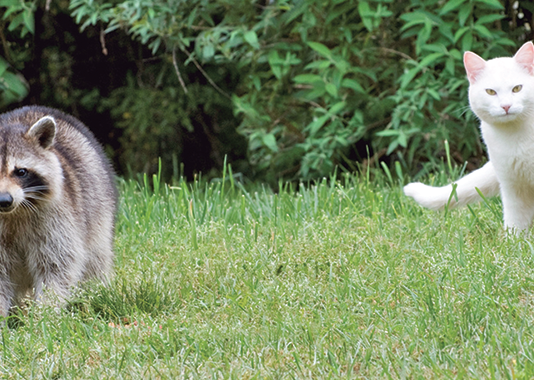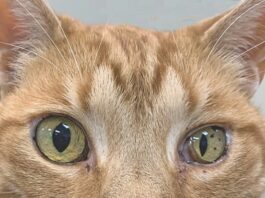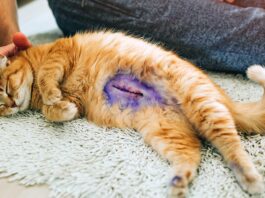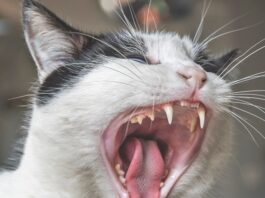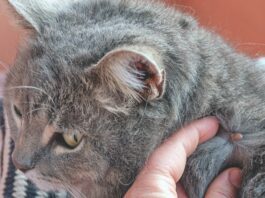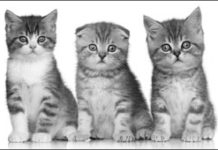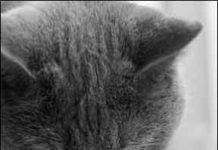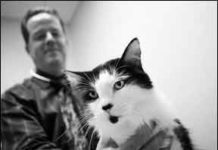Pursuing a Cure for Breast Cancer
Eighty to 90 percent of mammary tumors in cats are cancerous and can spread as rapidly as aggressive breast cancer does in humans. Researchers at the Cornell University College of Veterinary Medicine are hoping to improve treatment of mammary adenocarcinomas, with the long-term goal of a cure. Their pioneering focus: the role of stem cells in the disease. Gerlinde Van de Walle, DVM, Ph.D., Assistant Professor of viral pathogenesis and stem cell biology at Cornell’s Baker Institute for Animal Health, is working to identify adult mammary stem cells (MaSC) in both healthy and malignant feline and canine mammary gland tissues.
The Year-Round Threat of Ticks
Ticks pose a year-round threat to cats in every state — even if yours spends virtually all his time indoors. These minute arachnids have survived for millennia and often go undetected as they feed on their host’s blood, often causing serious illness and even death. “The major problem with ticks is that they are vectors for various infectious agents,” says dermatologist William H. Miller, VMD, at the Cornell University College of Veterinary Medicine.
Targeted Radiation Studied as Therapy for Oral Cancer
Treatment of oral squamous cell carcinomas (OSCC) has traditionally relied upon surgery, chemotherapy and/or radiation — with disappointing results. Cats with the rapidly spreading cancer, which accounts for 10 percent of all feline tumors, suffer pain when eating, drinking, grooming and breathing. Many are in such distress that they are euthanized.
An Unmistakable Sign of Anal Problems: Scooting
Scent is one of the ways cats communicate, and their anal glands help in that effort. The pea-sized glands, or sacs, produce an odor that aids in establishing identity and territory. When a cat defecates, the scent glands empty through two ducts located at the 4 o’clock and 8 o’clock positions of the anal sphincter, the band of muscle encircling the anus.
Study Puts Feral Cats in the Spotlight
A study published earlier this year that found free-ranging cats annually kill an estimated 2.4 billion birds and more than 20 million mammals drew heated responses from both wildlife and cat advocates.Lost in the controversy was the plight of outdoor cats themselves. They suffer from exposure to extreme weather and more injuries caused by cars, dogs, other cats and wild animals than those who live indoors, says Bruce G. Kornreich, DVM, Ph.D., Associate Director for Education and Outreach at the Feline Health Center at the Cornell University College of Veterinary Medicine.
Shelter Help Desk Reduces Admissions
When behavior problems seem insurmountable, many owners surrender their pets to shelters. The Nevada Humane Society in Reno lowered admissions by 8 eight percent with one simple change: It created the Animal Help Desk, a free phone service. “We see it as part of our mission to encourage and enable people to do right by their animals by helping them keep their pets in their homes whenever possible,” Executive Director Bonney Brown says in the e-newsletter No-Kill Nation from Maddie’s Fund.
The Many Roles of Whiskers
The old-fashioned term “the cat’s whiskers” means the height of perfection. It was popular in the ’20s, along with “the cat’s meow.” Debate ensued regarding the origin of the phrases, but people who used them certainly understood the unique capabilities of your cat’s most sensitive hairs.
Ask Elizabeth: June 2013
First of all, I want to thank and congratulate you for the obvious care that you have provided and concern you have for your baby. Given his age, you have clearly done something (many things!) right, and today’s question is an extension of the dedication that you have shown.
The Biggest Mistake in Giving Treats
Treats provide welcome rewards for good behavior, but their overly generous use can contribute to obesity. One reason is that owners don’t count treats as calories. “But the bigger problem is a multiple-person household in which every time someone walks by, they give the cat a treat,” says Joseph Wakshlag, DVM, Ph.D., Associate Professor of Nutrition at the Cornell University College of Veterinary Medicine.
Short Takes: June 2013
Obesity among pets in the U.S. continued to climb in 2012, with the number of overweight cats reaching an all-time high. Veterinarians reported that 58.3 percent of their feline patients — up from 55 percent over the previous year — were overweight or obese in the sixth annual survey by the Association for Pet Obesity Prevention (APOP). Given the cat population of 74.1 million in this country, that equals about 43.2 million cats, the association says. Surprisingly, the survey also revealed a “fat gap,” according to APOP founder Ernie Ward, DVM. When veterinarians asked owners to describe their fat cats’ body condition as too thin, normal, overweight or obese, 45.3 percent said normal.
Slowing Feline Cognitive Decline
Advances in veterinary medicine are keeping our cats alive longer, giving us precious extra years to spend with them. Sadly, extended life-spans also bring geriatric disorders such as feline cognitive dysfunction (FCD), similar to human Alzheimer’s in its symptoms. Like Alzheimer’s, FCD has no cure. And far fewer studies have been done on the feline version of the disease than have been done on the canine variety, so there are no approved medical treatments. But antioxidant supplements, along with mental and physical exercise, often improve the quality of life for both owners and cats.
Robo-Tuffy Provides Hands-on Training
Students honing their emergency skills at the Cornell University College of Veterinary Medicine owe gratitude to a special feline named Fluffy, who doesn’t meow and never needs a litter box. Fluffy is a robotic cat equipped with a mechanical pulse and heart, artificial lungs and electronic hardware and software capable of simulating cardiac arrest, lung diseases, shock and other medical conditions. She and a canine version named Jerry are believed to be the first of their kind used in veterinary schools. Think of Fluffy as a high-tech pet version of the popular battery-operated board game Operation, which tests players’ hand-eye coordination and motor skills.

